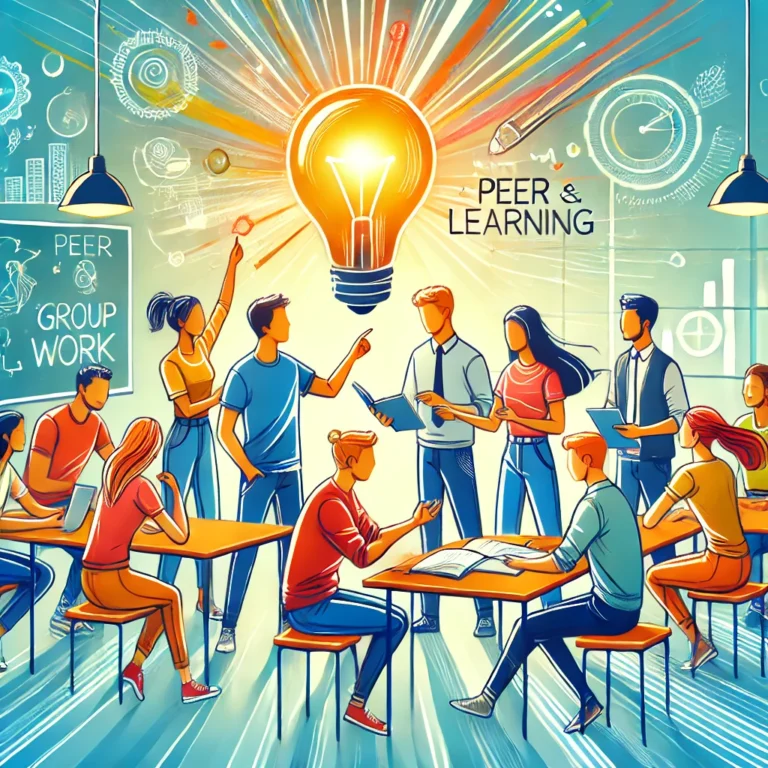Peer learning and group work are powerful instructional strategies that offer a range of benefits for students of all ages. By working together, students can enhance their understanding of course material, develop essential social skills, and build a sense of community in the classroom. When implemented effectively, peer learning and group work can transform the learning experience, making it more engaging, collaborative, and meaningful. Here’s why these strategies are so beneficial and how you can incorporate them into your teaching.
Enhances Understanding Through Collaboration
One of the most significant benefits of peer learning is the opportunity for students to deepen their understanding of the material by explaining concepts to one another. When students are tasked with teaching their peers or discussing ideas in a group, they must process the information more deeply, which leads to better retention and comprehension. This collaborative learning process allows students to learn from each other’s perspectives and fill in gaps in their understanding, leading to a more well-rounded grasp of the subject.
Builds Communication and Social Skills
Group work provides an ideal setting for students to develop critical communication and social skills. Working in groups requires students to express their ideas clearly, listen to others, and engage in constructive dialogue. These interactions help students practice essential skills such as negotiation, compromise, and conflict resolution. Over time, students become more comfortable working with others, which can boost their confidence and prepare them for collaborative environments in the future, both in education and in the workplace.
Fosters a Sense of Community
When students work together regularly, they begin to build a sense of community within the classroom. Group work encourages students to support one another, share responsibilities, and celebrate each other’s successes. This sense of belonging can lead to a more positive classroom environment, where students feel valued and motivated to contribute. A strong classroom community also promotes empathy and respect, as students learn to appreciate diverse perspectives and work together toward common goals.
Encourages Active Learning
Peer learning and group work shift the focus from passive reception of information to active engagement. Instead of simply listening to a lecture, students are actively involved in the learning process, discussing ideas, solving problems, and applying concepts in real-time. This active involvement helps students take ownership of their learning and stay engaged with the material. Additionally, the interactive nature of group work can make lessons more dynamic and enjoyable, which can increase students’ enthusiasm for learning.
Develops Critical Thinking and Problem-Solving Skills
Working in groups challenges students to think critically and solve problems collaboratively. Group tasks often require students to analyze information, evaluate different solutions, and make decisions as a team. This process encourages them to think creatively, consider multiple perspectives, and weigh the pros and cons of various approaches. Over time, these experiences help students develop strong critical thinking and problem-solving skills, which are essential for success in both academic and real-world contexts.
Promotes Accountability and Responsibility
In a group setting, each student is responsible for contributing to the success of the team. This shared responsibility promotes a sense of accountability, as students understand that their efforts (or lack thereof) can impact the entire group. When students know that their peers are relying on them, they are often more motivated to complete their tasks and participate actively. This accountability can lead to a greater sense of responsibility and discipline, which can benefit students in other areas of their academic and personal lives.
Prepares Students for Future Collaboration
Collaboration is a key skill in today’s interconnected world, where teamwork is often required in both professional and personal settings. By participating in group work, students gain valuable experience in working with others, managing group dynamics, and contributing to a collective goal. These experiences prepare them for future collaborative endeavors, whether in higher education, the workplace, or community projects. Learning to work effectively in a team is a skill that will serve students well throughout their lives.
Supports Diverse Learning Styles
Peer learning and group work can also accommodate diverse learning styles and needs. For example, visual learners might benefit from creating diagrams or charts as part of a group project, while auditory learners might excel in group discussions. Group work allows students to learn in a way that suits their individual strengths while also exposing them to different learning styles. This diversity of approaches can enrich the learning experience for all students.
Provides Opportunities for Feedback and Reflection
Group work offers students the opportunity to give and receive feedback from their peers, which can be a valuable learning tool. Constructive feedback helps students identify areas for improvement and develop their skills. Additionally, group work often involves reflection, where students can discuss what went well, what challenges they faced, and how they can improve in future collaborations. This reflective practice encourages continuous learning and growth.
Increases Engagement and Motivation
Finally, peer learning and group work can increase student engagement and motivation. When students are actively involved in their learning and have the opportunity to collaborate with their peers, they are more likely to stay interested and invested in the material. The social aspect of group work can also make learning more enjoyable, as students have the chance to connect with their classmates and work together toward a common goal.
In conclusion, peer learning and group work offer numerous benefits that can enhance the educational experience for students. By fostering collaboration, critical thinking, and communication skills, these strategies help students develop the tools they need to succeed in school and beyond. When implemented thoughtfully, peer learning and group work can create a more dynamic, inclusive, and supportive classroom environment where every student has the opportunity to thrive.


